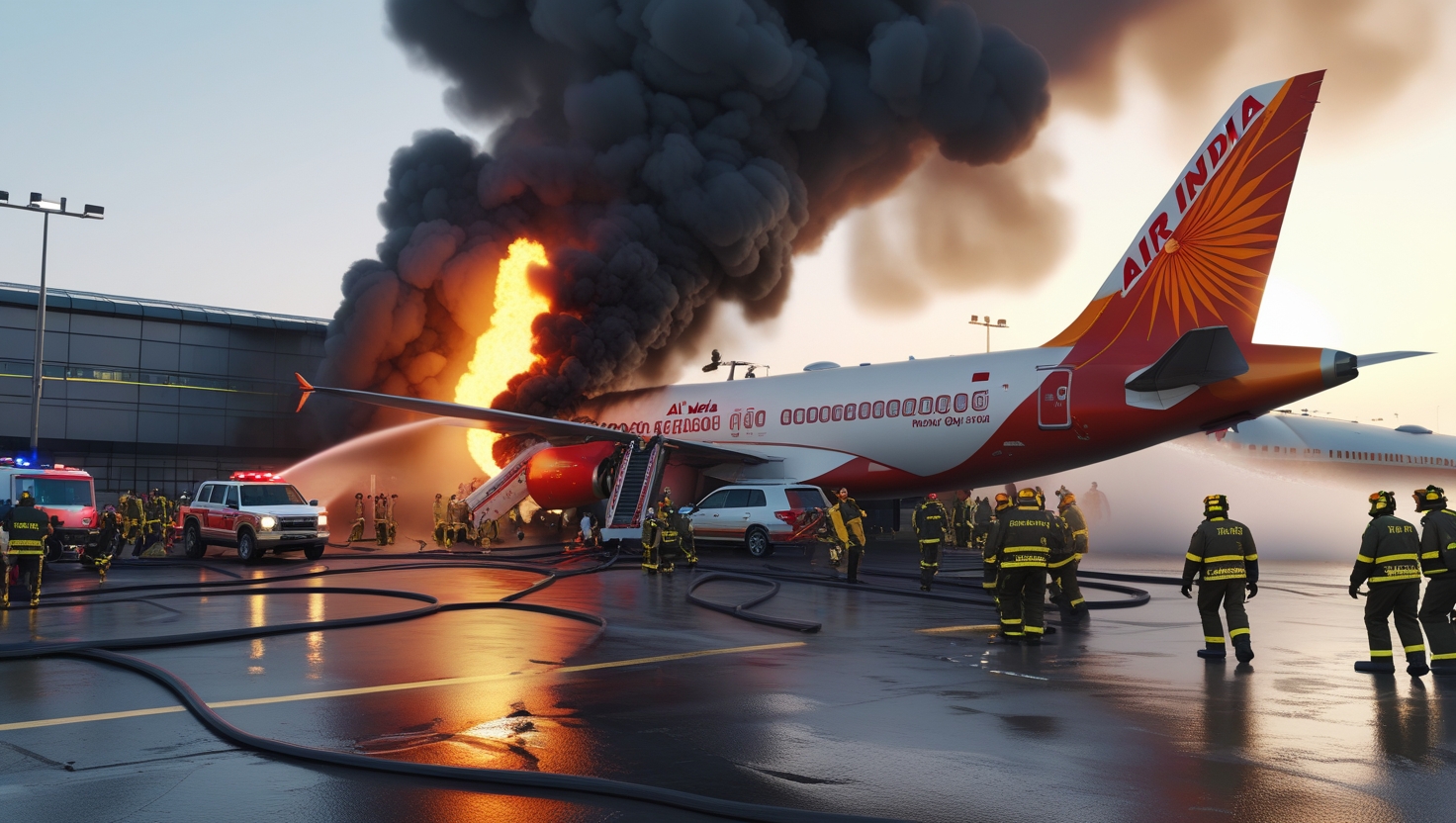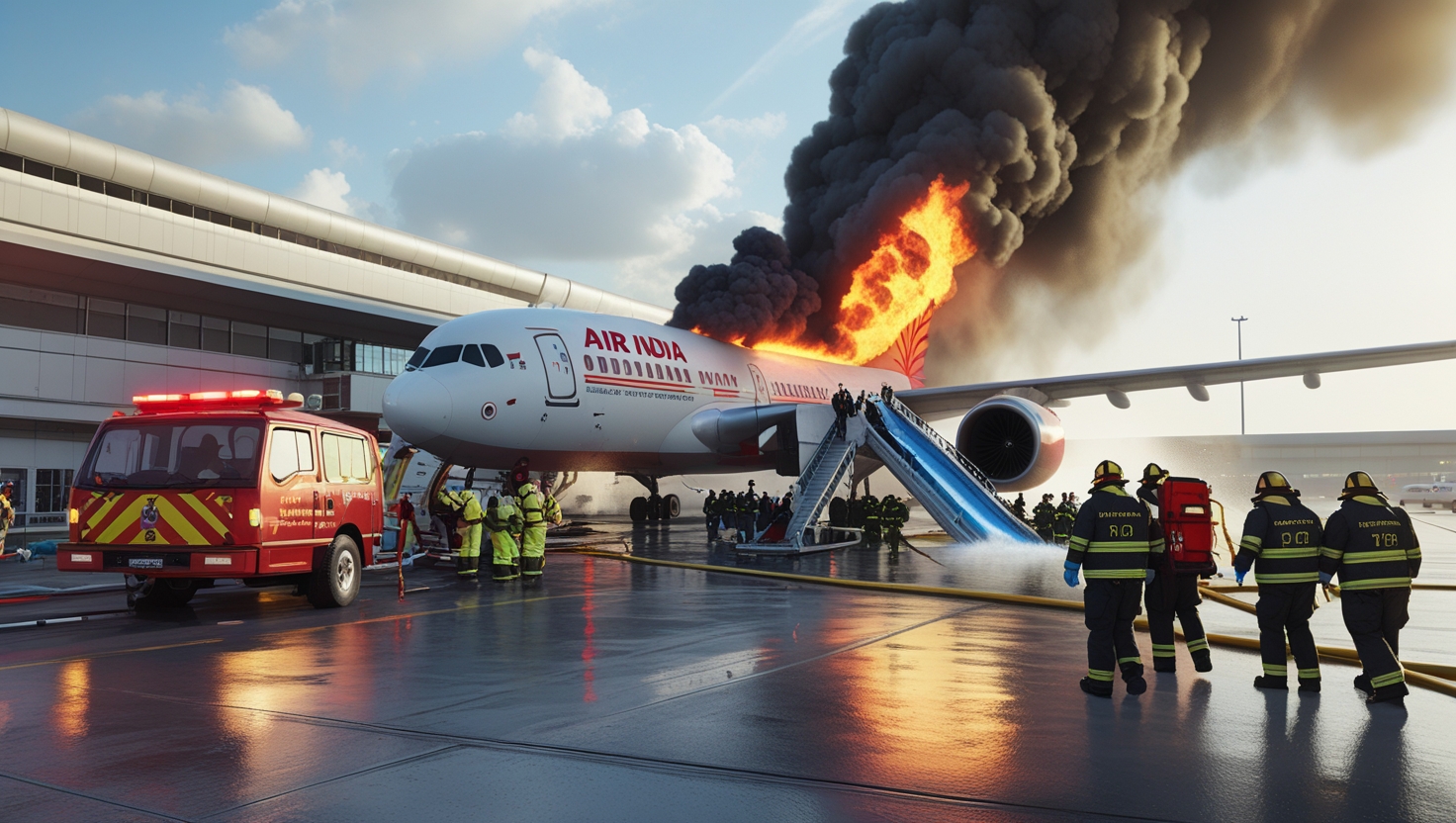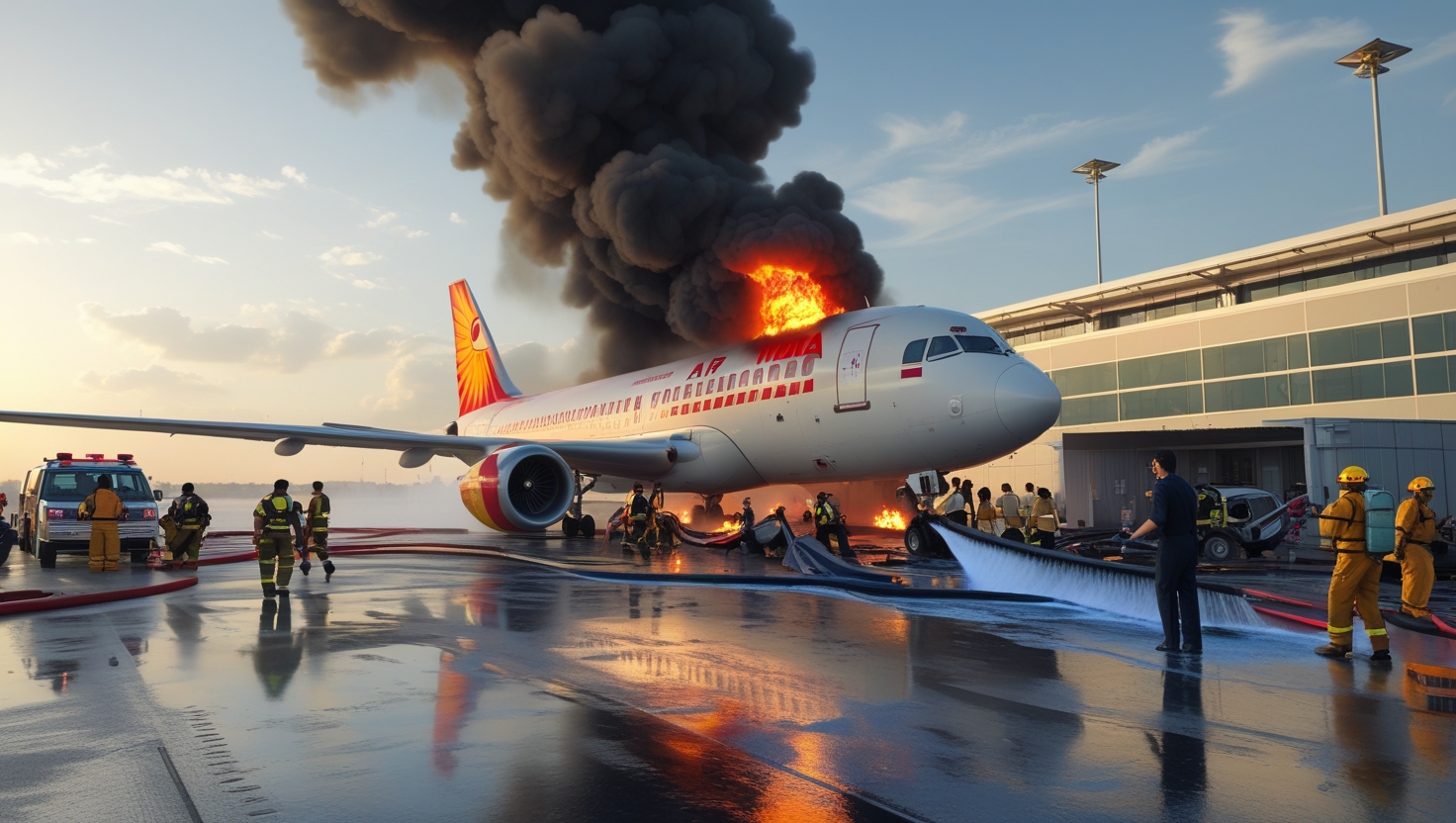Massive Scare as Air India Flight Fire Erupts Post Landing in Delhi: All Passengers Safe

A frightening incident unfolded at Indira Gandhi International Airport on Monday, July 22, 2025, as an Air India flight fire was reported just moments after the aircraft arrived from Hong Kong. The aircraft, carrying over 180 passengers, witnessed a technical snag that resulted in smoke and a minor blaze from the undercarriage while passengers were still disembarking. Fortunately, due to the timely action by the airport emergency services and crew, the Air India flight fire was swiftly brought under control with no injuries reported. The event, however, has reignited concerns about airline safety protocols and aircraft maintenance standards in India.
Eyewitness Accounts Paint Picture of Panic and Relief
According to several passengers aboard flight AI-317, the situation escalated quickly as smoke began emanating from the aircraft’s wheels shortly after it came to a complete halt on the tarmac. Many passengers were still retrieving their baggage and preparing to exit when alert airport personnel noticed the first signs of the Air India flight fire and acted with remarkable speed.
“The flight had landed smoothly. We were standing in line to get off when someone shouted ‘fire!’ and everyone panicked,” said Rajeev Mehta, a returning businessman from Hong Kong. “We could smell something burning. The crew stayed calm and instructed us to move quickly but not to push. There was visible smoke outside the window.”
Ground staff and fire brigade units stationed at the Delhi airport were quick to respond. Within minutes, foam and other fire-suppressing agents were deployed to extinguish the Air India flight fire, and all passengers were safely escorted out of the plane. Several passengers praised the airline’s crew and the airport authorities for handling the emergency efficiently, preventing what could have easily become a disaster.
Technical Malfunction Suspected as Cause of Air India Flight Fire
Initial investigations suggest that a hydraulic oil leak may have triggered the Air India flight fire, a problem that sometimes affects aircraft due to intense braking or technical failure. Aviation safety experts have indicated that the incident, although alarming, was contained well due to rigorous emergency preparedness by the authorities.
The Directorate General of Civil Aviation (DGCA) has launched an inquiry into the cause of the Air India flight fire, and maintenance logs of the aircraft in question are being closely examined. The aircraft, a Boeing 787 Dreamliner, had reportedly undergone standard checks before departure from Hong Kong, but officials are now probing whether post-landing technical issues might have led to the incident.
Safety Protocols Under Scanner After Air India Flight Fire
As the news of the Air India flight fire spread, aviation experts and industry professionals raised pertinent questions regarding the robustness of safety checks and maintenance procedures followed by national carriers. Though no lives were lost, the incident has become a flashpoint in the larger conversation about airline safety in India.
The incident comes at a time when Indian carriers are expanding their international routes, acquiring new fleets, and investing heavily in overseas collaborations. The Air India flight fire, however, exposes potential blind spots in the rapidly evolving aviation industry, especially in ensuring uniform safety standards across aircraft models and destinations.
Air India issued an official statement shortly after the incident, confirming the fire and emphasizing the airline’s commitment to passenger safety. “There was a minor fire in the undercarriage area of flight AI-317 after it landed in Delhi from Hong Kong. All passengers were safely disembarked, and the situation was brought under control swiftly. A detailed investigation is underway,” the airline stated.
Passengers Laud Crew for Their Composure During Air India Flight Fire
The crew’s professionalism was a common theme in the reactions shared by many travelers. In high-stress situations such as the Air India flight fire, the calm demeanor and decisive actions of the airline staff were instrumental in averting chaos.
“Our flight attendants guided us out while maintaining order. One of them was checking each seat to make sure no one was left behind. I was scared, but they really made a difference,” said 27-year-old student Aanya Bhattacharya.
The captain of the flight, who has 12 years of flying experience, was praised for his timely communication with Air Traffic Control and adherence to protocol. The fire crew at IGI airport was also commended for reaching the aircraft within moments and effectively neutralizing the Air India flight fire before it could spread.
Unraveling the Broader Impact of the Air India Flight Fire Incident
The Air India flight fire incident is now a national talking point. It has not only raised immediate operational concerns for the airline but also triggered a wave of audits and checks across major Indian airports. Aviation watchdogs and regulatory bodies are expected to conduct rigorous assessments of fleet health, with Air India likely to face extra scrutiny in the coming weeks.
Passenger unions and airline associations have started demanding greater transparency regarding aircraft servicing schedules, flight maintenance histories, and pre-departure inspection protocols. Social media is flooded with footage and accounts from AI-317, giving rise to both appreciation for the rescue efforts and questions about how such a Air India flight fire could start so suddenly.
The airline industry has historically maintained that fire hazards are extremely rare due to the strict regulations and technology in place. But when an incident like the Air India flight fire unfolds right at the gates of one of the country’s busiest international airports, it forces all stakeholders to reassess assumptions and priorities.
Timeline of Events Leading to the Air India Flight Fire Emergency
Flight AI-317 departed from Hong Kong International Airport at approximately 1:15 PM local time, with 184 passengers and 12 crew members on board. The 5-hour journey was uneventful until the aircraft touched down in Delhi around 6:45 PM IST. According to radar logs and airport CCTV footage, the aircraft taxied to the arrival gate without incident.
However, once the parking brake was applied and passengers began to disembark, a technician monitoring ground operations noticed smoke emerging from the right-side main landing gear. Within seconds, a small fire erupted near the wheel well, believed to have originated from a hot brake assembly or leaking hydraulic fluid.
The technician immediately alerted the Air Traffic Control and the airport’s emergency response team. Within three minutes, fire trucks reached the aircraft and began dousing the affected area with foam. The cabin crew, upon receiving instructions from the cockpit, expedited passenger exit procedures without opening emergency slides, as the cabin itself remained unaffected by flames.
The Air India flight fire was fully extinguished by 6:54 PM, less than 10 minutes after detection, preventing further damage. Airport officials confirmed that none of the passengers required medical assistance and were promptly moved to the terminal area for routine check and assistance.
Repercussions and Immediate Safety Checks Post Air India Flight Fire

Following the containment of the Air India flight fire, aviation authorities immediately grounded the aircraft for comprehensive inspections. Engineers began examining the brake systems, hydraulic lines, and wheel assemblies. According to unofficial sources, early assessments suggest a possible overheating of the brake units due to extended taxiing and delayed cooling — a factor known to contribute to fire hazards in aircraft.
The DGCA also issued a circular requiring all Boeing 787 aircraft operating under Indian carriers to undergo a targeted inspection of their landing gear systems. In addition, the ministry of civil aviation directed all airport fire response units to revise their training and response benchmarks to ensure even faster containment in future events involving Air India flight fire-like situations.
Meanwhile, Air India proactively canceled three flights scheduled to be operated by similar aircraft pending technical reviews. Although this has caused inconvenience to a few hundred passengers, many welcomed the decision as a responsible safety-first approach following the Air India flight fire shock.
Historical Context: Other Notable Incidents Involving Aircraft Fires
The Air India flight fire incident echoes previous global events involving aircraft fires that ended with either tragedy or narrow escapes. In 2010, an Air India Express flight crash-landed in Mangalore due to a runway overshoot and caught fire, claiming over 150 lives. Although the context is different, the aftermath led to policy changes and stricter landing protocols.
Internationally, the 2013 fire involving an Ethiopian Airlines Boeing 787 Dreamliner at London’s Heathrow was linked to a fault in the aircraft’s emergency beacon. That incident, like the one in Delhi, did not result in casualties but led to a global grounding of the Dreamliner fleet until the problem was resolved.
Each such incident becomes a case study in aviation history, compelling regulators and airlines to revisit existing safety frameworks. The Air India flight fire will likely be treated with similar importance, particularly because it involved an international route and a modern aircraft model.
Experts Speak: Calls for Comprehensive Overhaul
Speaking to aviation portal FlightGlobal, retired pilot and safety analyst Captain Ranjit Sen noted: “Incidents like the Air India flight fire are rare, but they are not flukes. They are a reflection of small oversights — a missed temperature check, an overlooked fluid leak. Airlines need to evolve from reactive to predictive maintenance systems.”
Aviation consultant Priyanka Lall stressed the need for technological upgrades. “We’re still relying heavily on human-led inspections in many cases. India must adopt AI-powered diagnostic tools that monitor aircraft health in real time,” she said.
Several international experts have suggested that Indian aviation should align more aggressively with FAA (Federal Aviation Administration) and EASA (European Union Aviation Safety Agency) norms. These include predictive analytics, blockchain-based maintenance logs, and digital twin technology.
International Implications and India’s Aviation Reputation
With India’s aviation sector poised to become the third largest in the world, incidents like the Air India flight fire have ramifications beyond national boundaries. Foreign passengers, code-share partners, and global safety analysts closely watch such developments.
Already, some international news outlets have carried the story, emphasizing the need for heightened caution in Indian aviation. While no travel advisories have been issued, this event could influence airline insurance premiums, aircraft leasing terms, and fleet evaluation reports for Indian carriers.
This is why it’s crucial that Indian authorities not only resolve the issue internally but also demonstrate to the world that robust, transparent systems are in place to prevent recurrence.
Conclusion: A Wake-Up Call and the Way Forward
The Air India flight fire at Delhi airport may have ended without casualties, but it has left a deep imprint on public consciousness and the aviation industry’s psyche. As inquiries proceed, it’s vital that all stakeholders — airlines, regulators, engineers, and crew — unite to foster a culture of anticipatory safety and rapid response.
The incident should also serve as a reminder that while India’s aviation industry continues to soar, the true measure of progress lies not just in fleet expansion but in unwavering adherence to world-class safety standards.
Only then can passengers feel truly secure when they board a flight, trusting that their journey will not be marred by incidents like the Air India flight fire.

